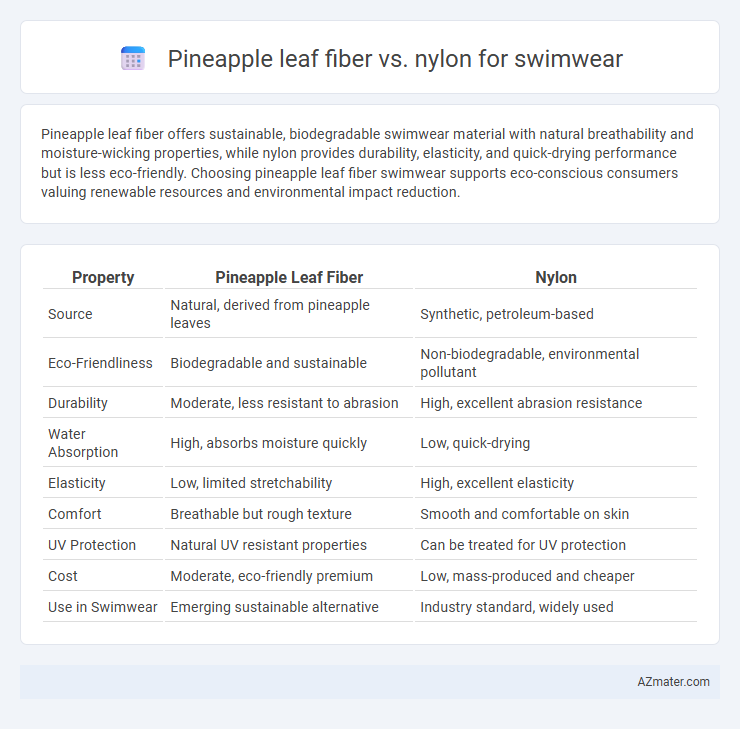Pineapple leaf fiber offers sustainable, biodegradable swimwear material with natural breathability and moisture-wicking properties, while nylon provides durability, elasticity, and quick-drying performance but is less eco-friendly. Choosing pineapple leaf fiber swimwear supports eco-conscious consumers valuing renewable resources and environmental impact reduction.
Table of Comparison
| Property | Pineapple Leaf Fiber | Nylon |
|---|---|---|
| Source | Natural, derived from pineapple leaves | Synthetic, petroleum-based |
| Eco-Friendliness | Biodegradable and sustainable | Non-biodegradable, environmental pollutant |
| Durability | Moderate, less resistant to abrasion | High, excellent abrasion resistance |
| Water Absorption | High, absorbs moisture quickly | Low, quick-drying |
| Elasticity | Low, limited stretchability | High, excellent elasticity |
| Comfort | Breathable but rough texture | Smooth and comfortable on skin |
| UV Protection | Natural UV resistant properties | Can be treated for UV protection |
| Cost | Moderate, eco-friendly premium | Low, mass-produced and cheaper |
| Use in Swimwear | Emerging sustainable alternative | Industry standard, widely used |
Introduction to Sustainable Swimwear Materials
Pineapple leaf fiber is a natural, biodegradable material derived from agricultural waste, offering an eco-friendly alternative to traditional synthetic fibers used in swimwear. Nylon, while durable and lightweight, is petroleum-based and contributes significantly to microplastic pollution and carbon emissions in textile production. Sustainable swimwear materials like pineapple leaf fiber reduce environmental impact through renewable sourcing and enhanced biodegradability without compromising performance.
What is Pineapple Leaf Fiber?
Pineapple leaf fiber is a sustainable natural textile derived from the leaves of the pineapple plant, known for its strength and eco-friendly properties. It offers breathability, moisture absorption, and biodegradability, making it a green alternative to synthetic fibers like nylon. Unlike nylon, which is petroleum-based and non-biodegradable, pineapple leaf fiber reduces environmental impact and supports sustainable fashion innovations, especially in swimwear.
Understanding Nylon as a Swimwear Fabric
Nylon is a synthetic polymer prized in swimwear for its durability, elasticity, and quick-drying properties, making it ideal for prolonged water exposure and active use. Unlike pineapple leaf fiber, which is natural and biodegradable, nylon offers superior stretch and resistance to chlorine and UV damage, contributing to long-lasting performance. However, nylon's synthetic nature raises environmental concerns, prompting some brands to explore recycled alternatives for sustainable swimwear production.
Environmental Impact: Pineapple Leaf Fiber vs Nylon
Pineapple leaf fiber is a sustainable swimwear material derived from agricultural waste, offering biodegradability and low environmental impact due to minimal chemical processing and reduced water usage. Nylon, a synthetic fiber made from petrochemicals, contributes significantly to pollution through energy-intensive production, non-biodegradability, and microplastic pollution in marine ecosystems. Choosing pineapple leaf fiber over nylon enhances eco-friendly swimwear options by reducing carbon footprint and preventing long-term environmental damage associated with synthetic fabrics.
Durability and Performance Comparison
Pineapple leaf fiber offers excellent breathability and eco-friendly durability, making it resistant to saltwater and chlorine compared to traditional swimwear materials. Nylon excels in high elasticity and quick-drying performance but tends to degrade faster under prolonged exposure to UV rays and chemicals. Choosing pineapple leaf fiber swimwear ensures sustainable strength and moderate stretch, while nylon provides superior fit and resilience for intense water activities.
Comfort and Feel: Natural vs Synthetic Fibers
Pineapple leaf fiber offers a breathable, soft texture that enhances comfort with natural moisture-wicking properties, making it ideal for sensitive skin in swimwear applications. Nylon, a synthetic fiber, provides a smooth, elastic feel with excellent durability and quick-drying capabilities but can sometimes cause discomfort or irritation during extended wear. Choosing between pineapple leaf fiber and nylon depends on prioritizing eco-friendly, natural comfort versus the performance and resilience of synthetic materials.
Water Resistance and Quick-Dry Capabilities
Pineapple leaf fiber swimwear offers natural water resistance due to its hydrophobic properties, allowing for comfortable wear without excessive water absorption. Nylon, widely used in swimwear, excels in quick-dry capabilities because of its synthetic structure that repels water and dries rapidly after exposure. Compared to nylon, pineapple leaf fiber provides eco-friendly benefits while maintaining competitive water resistance, though nylon typically outperforms in fast drying times.
Design and Aesthetic Versatility
Pineapple leaf fiber offers a unique textured appearance and natural matte finish, providing swimwear designers with an eco-friendly alternative to traditional fabrics. Its organic patterning allows for innovative designs that emphasize sustainability without compromising style. Nylon, known for its smooth surface and high elasticity, supports vibrant color retention and sleek silhouettes, making it highly versatile for creating form-fitting and polished swimwear looks.
Cost and Market Availability
Pineapple leaf fiber offers an eco-friendly, biodegradable alternative to nylon swimwear fabric, but its cost remains higher due to limited production and processing scalability. Nylon dominates the swimwear market with widespread availability and lower price points, benefiting from established manufacturing infrastructure. Consumers seeking sustainable options may face premium pricing and fewer choices compared to the cost-effective, mass-produced nylon swimwear materials.
Future Trends: The Shift Toward Eco-Friendly Swimwear
Pineapple leaf fiber is emerging as a sustainable alternative to nylon in swimwear, offering biodegradability and reduced environmental impact compared to traditional synthetic fibers. Innovations in bio-based textiles are driving a shift towards eco-friendly swimwear, with pineapple leaf fiber providing breathability, durability, and a lower carbon footprint. Market demand for sustainable fabrics is expected to accelerate the adoption of pineapple leaf fibers as consumers prioritize environmental responsibility in swimwear choices.

Infographic: Pineapple leaf fiber vs Nylon for Swimwear
 azmater.com
azmater.com